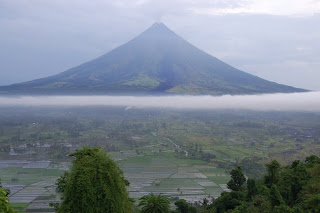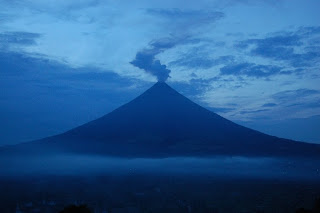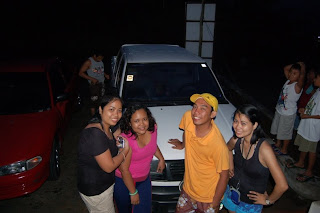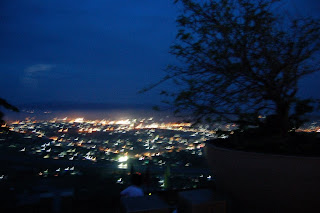Road Trip Part II: Scenic Mount Mayon--The Pride of Albay

The Imposing Beauty of a Near-Perfect Cone: Mayon Volcano of Albay
Just a few months back, Mount Mayon stole the headlines once again. The impending eruption, which fortunately did not materialize, gave many of the residents living near the volcano a scare...but promised tourists and sightseers a view like no other. Thus, despite the clear danger of being near a temperamental beauty that is Mount Mayon, at a time when it was about to erupt no less, people still could not resist to be awed by its sight. I didn't witness this near-eruption stage save on TV, but decided nonetheless to share my Mount Mayon sight-seeing trip not too long ago.
Mount Mayon is the queen of volcanoes in the Philippines. Not only does it have an attitude--not a single decade has passed in my entire lifetime that the volcano did not act up, spew ashes, shake the earth, cough out molten rocks and force people to evacuate--it is also, above all, a sight to behold.

Mount Mayon is one of the most active volcanoes in the Philippines, but more than that, it is famous for its shape of an almost-perfect cone. The name "Mayon" is said to have come from the word magayon, which in the Bicol dialect means "beautiful". Folktales have it that there was once a tribal princess named Daragang Magayon (beautiful lady) whose beauty attracted a suitor. The two fell madly in love with each other but the man,however, came from a different tribe and their inter-tribal marriage was greatly met with oppositions. The rosy love affair ended in the early demise of the lovers when, due to war that broke out between their tribes, the ala-Romeo and Juliet couple decided to end their lives. Hence, upon the tomb of Daragang Magayon emerged the volcano now known as Mount Mayon.
So that is the folklore behind the Mount Mayon--with an additional oomph on my part--and before I get carried away with further folkstory telling, here is the story of our adventure =)

Per my previous post, our group (Don, Von, Johann, Mel, Kath and moi, byahera) went to Sorsogon to explore Paguriran Island (pls. refer to previous post). On the way there and back, we decided to drop by at some of the tourist spots in Albay for a good view of Mt. Mayon. Albay is one of the provinces of Region V or the Bicol Region, which is around 500 kilometers away from Manila. It is adjacent to Camarines Sur and Sorsogon and can be reached by bus or by airplane, and lately, by train. Travel time for bus transpo is around 12 hours and for plane, 50 minutes. Fare for airconditioned buses ranges from Php 700 to a little over Php 1000, while that for airplane varies according to season and booking time. Major airline companies offer daily flights to Legazpi City, Albay's capital, and travelers will be wise to wait for those occasional promo flights :) For the more cash-strapped, there is the option of non-airconditioned or ordinary bus in which fare is only Php350 to 500. Anyhoo, the latest news is that the PNR (Philippine National Railway) is already catering trips to Albay on a daily basis, but only up to Ligao City which is still around 1 hr away from Legazpi. The newly revamped Bicol Express trains look quite good for a twelve-hour trip. There are aircon sleeper cabins which could be quite comfy @ prices comparable with that of buses. Plus, it's clean. So enjoy your trip! :)
Anyways, our first stop was the Cagsawa Ruins.

The people, which you can see in the picture donned in colorful costumes, are not a regular part of the scenery though. We were just lucky to be there just when these groups of students were shooting for a television program. Entrance fee is Php 10.


When the volcano had a major eruption in 1814, the people of Cagsawa, Daraga sought refuge inside the Cagsawa Church believing that they would be safe inside. They stayed and locked themselves in until the church itself was engulfed by the smoldering lava. Only the bell tower survived the catastrophe; it now stands as a marker of that fateful eruption. The bell tower is an oft-visited tourist destination in Albay, as it serves as a reminder of the destructive wrath of the beautiful volcano.
On our way home from Paguriran, Sorsogon, we dropped by at Daraga Church. I have always known Daraga Church as the church in a hill due to its elevated location. The view and the ambiance was fantastic. Unfortunately, we were not able to go inside even for a brief moment of prayer, as we were not dressed appropriately having just been from a beach outing. All the same, we satisfied our photograph-manic tendencies by taking dozens of pictures of ourselves in every angle imaginable.


To cap our long but fun trip, we stopped at Lignon Hill out of curiosity for this newly developed place. We have our own vehicle so we were spared from the long and seemingly tiring hike. Yet on second thoughts, it may had been fun to walk the winding and sloping road in the company of crazy friends. My estimate is that it would take around 30 to 40 minutes to reach the zenith of the place--and a lot of huffing and puffing on my part.

Lignon Hill is a hill--as its name implies--directly opposite the Mount Mayon. I found out that the place, which is an observatory park, just began its operations in 2008. It is quite successful already, with its main attraction being the unobstructed view of the Mayon volcano on one side, and of Legazpi City on the other side. While the view of the volcano is already breathtaking as it is, the view of downtown Legazpi is equally picturesque especially at night time. In addition, the park offers different recreational activities, such as a zip line for Php 250 and all-terrain vehicles. We did not try any of those because, not admitting that we are afraid of heights :), we were busy with--what else???--taking pictures!! The voluminous number of shots stacked in the memory card of Don's camera silently speaks for our happy picture-taking spree. No regrets that we impulsively included Lignon hill in our itinerary.








Not far from the hill is the Albay Wildpark and Recreation, but we decided against going there since it was already dark and we still have to find a place to stay. So after buying our dinner at one of the ubiquitous chicken rotisseries in Legazpi, we scouted for a hotel or resort. Don suggested that we spend the night in a resort lest anyone not yet satisfied with the Paguriran outing still wants to swim. We found this place in Daraga (I forgot the name)--a resort, nothing extraordinary--which charges P1200 for a 12-hour stay. Good thing that there were five of us, sans Johann, to share this price. We were also super tired anyway that after chowing down our dinner of roasted chicken, lots of leftover rice, soft drinks and banana, and after a warm bath, we all immediately fell into deep slumber.Tired and squeezed in the queen-size bed shared with mel and von, I was happy nonetheless with the memories stored in my travel memory bank. Early the following day, we drove home, eager to finally have some decent rest and to share our adventure to anyone who's willing to listen
LEGAZPI/MAYON ADVENTURE HOW TO'S:
1. Ride a bus going to Legazpi City. Expect the trip to last for 12 hours more or less. You can stave off boredom by enjoying the countryside scenery (for day trip) or catching some sleep. Also prepare for a bumpy ride in some parts of the journey. One-way fare could range from Php 700 to Php 1000. If you travel by plane, it would be wise to book early. Travel time by plane only takes 50 minutes. Almost every major local airline cater daily flights to Legazpi City.
2. Transportation around Legazpi City and other areas of Albay is relatively cheap. The standard fare of Php 7 applies. However, be wary of tricycle drivers since they are ready to bleed every cent out of you. If you want to ride a tricycle, be smart and haggle. I heard that there are taxis already. The rate is presumably the same with Manila rate.
3. There are many hotels in Legazpi City, such as the Alicia Hotel, Hotel Casablanca, Legazpi Tourist Inn, Magayon Hotel, Albay Hotel and others. P2,000 is usually more than enough for a double room and a breakfast. Budget travelers, however,would be delighted with the room rates of Sampaguita Tourist Inn, which could go as low as Php 600 for an air-conditioned room (twin sharing) and Php 300 for fan room.
4. Dining places are all over. There are the staple Jollibee, McDonald's, Chowking and Greenwich, but if you want a taste of Bicolano fast food, don't miss Bigg's Restaurant. This is the largest food chain in the Bicol region (yup! with more franchises than Jollibee)--food is great and at a reasonable price. Embarcadero is the new lifestyle hub in the city where you can find a number of restaurants and retail stores, among others.
5. Whet your appetite with the famous Bicol express! Try also the laing or natong and pinangat, which are known Bicolano dishes.
6. Albay is famous for native handicrafts made of abaca, such as bags, purse and slippers. These are perfect pasalubongs! Also, don't forget to try and bring some candied pili nuts to your family, friends and co-workers :)
7. Lastly, relax and enjoy. After all, this is what it's all about.



Comments
Post a Comment